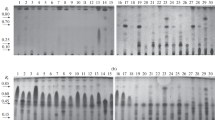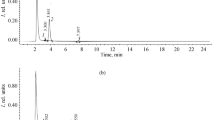Abstract
THE production by micro-organisms of substances inhibitory to the growth of higher plants is well documented. The purpose of this communication is to report a potent inhibitor of plant growth, as measured by our duckweed (Lemna) test1. Solvent extraction at pH. 9.0 of fitrates derived from fermentations of an unidentified Streptomyces led to the recovery of a light tan solid, designated crude PA-180. This preparation exhibited considerable antibiotic activity against various micro-organisms (for example, minimum inhibitory concentrations of 3.12 and 6.25 µgm./ml. against Streptococcus faecalis and Corynebacterium diphtheriae, respectively; we wish to thank Dr. A. R. English for the anti-microbial testing and Dr. T. M. Lees and Mr. M. Lynch for papergram determinations). This crude PA-180 preparation also was shown to exhibit remarkable plant growth activity. This inhibitory effect was first noticed in a routine test being conducted for an evaluation of its growth effect and its phytotoxicity. The results (Fig. 1) were noteworthy since they demonstrated a strong inhibitory action with no apparent toxic symptoms. The plants at all test-levels were normal except for a decreased size. The original experimental transfer consisted of one rosette of four fronds. These four original fronds are easily detected among the tiny daughter fronds at the 5, 10 and 20 p.p.m. test-levels. The number of fronds is not appreciably decreased, as opposed to the size and weight of the plants.
Similar content being viewed by others
References
Nickell, L. G., and Finlay, A. C., J. Agric. and Food Chem., 2, 178 (1954).
Wallen, V. R., Sutton, M. D., and Skolko, A. J., Phytopath., 40, 156 (1950).
Norman, A. G., Science, 121, 213 (1955).
Nickell, L. G., Phyton, 11, 93 (1958).
Tulecke, W., and Nickell, L. G., Trans. N.Y. Acad. Sci., 22, 196 (1960).
Norman, A. G., Soil Sci. Soc. Amer. Proc., 24, 109 (1960).
Norman, A. G., Arch. Biochem. and Biophys., 58, 461 (1955).
Hall, W. C., Johnson, S. P., and Leinweber, C. L., Tex. Agric. Exp. Sta. Bull., 789 (1954).
Wirwille, J. W., and Mitchell, J. W., Bot. Gaz., 111, 491 (1950).
Krewson, C. F., Wood, J. W., Wolfe, W. C., Mitchell, J. W., and Marth, P. C., J. Agric. and Food Chem., 7, 264 (1959).
Sachs, R. M., Lang, A., Bretz, C. F., and Roach, J., Amer. J. Bot., 47, 260 (1960).
Bonner, J., Amer. J. Bot., 36, 429 (1949).
Day, M. W., Mich. Agric. Exp. Sta. Quart. Bull., 30, 241 (1947).
Tolbert, N. E., J. Biol. Chem., 235, 475 (1960).
Tolbert, N. E., Plant Physiol., 35, 380 (1960).
Wittwer, S. H., and Tolbert, N. E., Plant Physiol., 35, 871 (1960).
Schoene, D. L., and Hoffman, O. L., Science, 109, 588 (1949).
Author information
Authors and Affiliations
Rights and permissions
About this article
Cite this article
NICKELL, L., CELMER, W. A Potent, Non-Toxic Plant-growth Inhibitor from an Antibiotic Fermentation. Nature 192, 1098–1099 (1961). https://doi.org/10.1038/1921098a0
Issue Date:
DOI: https://doi.org/10.1038/1921098a0
- Springer Nature Limited
This article is cited by
-
Structure-Phytoactivity Relationships in the Penicillins
Nature (1965)





